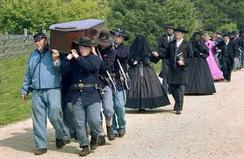
My last parish was quite large, and we had around three funerals a week. After Mass, the funeral director would usually offer me a ride to the cemetery. I would hop into the front seat of the hearse, with the deceased person behind us. We would drive through the city at a snail’s pace, leading a slow procession of cars with their lights on. People would clear the way for us, some crossing themselves, many looking awkwardly in the other direction. Few want to think about death, or cross its path on the way to work. Jesus crosses just such a funeral procession in the gospel today, a turba civitas multa—a large crowd from the city, accompanying lonely a widow who walks slowly behind the bier of her only son. No one, especially in the ancient world, was more forsaken than an old woman without husband or children. She was cast entirely upon the mercy of God, for men had failed her.
Jesus touches death
Jesus was moved with heartfelt mercy, with “misericordia,” for her. He begs her: “Please, my daughter, do not cry.” He steps forward and--shockingly—touches the coffin. Jewish law forbade touching anything touched by death. Jesus would have been rendered unclean for eight days. The law sought to protect people’s health from the contagion that swarms around putrefying human bodies. The law sought to protect people’s faith from the despair and horror that death provokes. Jesus does not ignore this law; he simply eliminates the evil, rendering the law inapplicable. He removes the contagion, the despair, the horror. He removes death and restores life to the young man with one command: “arise.” Be made clean. Shake off your mortality like you shake off a good night’s sleep and arise to a new day.
Like any man, Jesus loathes death. In the face of his friend Lazarus’s death, whose body had been decaying rapidly for four days, the Gospel says Jesus was “shaken in spirit;” “he trembled in anguish,” literally, he “snorted in spirit.” He weeps over Lazarus and his sisters; we imagine this poor widow’s misery moved him to tears as well. He is moved with compassion--he moves forward to confront death at close quarters. He is willing to be defiled, and in the end, he will die, in order to defend his loved ones from death.
What to do
As I mentioned earlier, I would ride in the hearse to the cemetery after funeral Masses. Funeral directors are generally good-natured, and I became quite acquainted with some of them. But as we chatted on the way to the cemetery, we were both aware of the third passenger in the hearse. Death rode with us, the remains of a man or woman, whose submission to death caused dread and confusion to everyone who knew him or her. It was at the graveside that death attained its greatest triumph. I would speak the brief committal prayers, and for veterans the American Legion would fire a 21-gun salute and play taps. But finally we had to lower the coffin, and cover the body with dirt, and go home. It was at this point that many would break into storms of weeping, deep sobs, and the priest would have to turn his back on them and get back to the parish. If only the priest could say to these people: noli flere. “Do not cry.” If only he could touch the casket and say: adulescens, tibi dico, surge! “Get up!” “And the dead youth got up, and Jesus gave him back to his mother.”
“Fear seized them all,” the Scriptures say, “and they glorified God.” If the Lord Jesus does not strike fear into us, we have not yet met him. To meet death is frightening, but meet one mightier than death is terrifying. This morning we bow low before this One who has met death head on and destroyed it. We bow low in humility and in love to Christ, who begs us not to cry as we face the confusion and abandonment of death. There is something the priests can do for those weeping at gravesides. They can believe in the One sent by God, and help others to believe in Him. They can proclaim that love is stronger than death, and that God is love. He will meet death ahead of us, and touch us, if we allow him, and raise us up with him on the third day.


 RSS Feed
RSS Feed